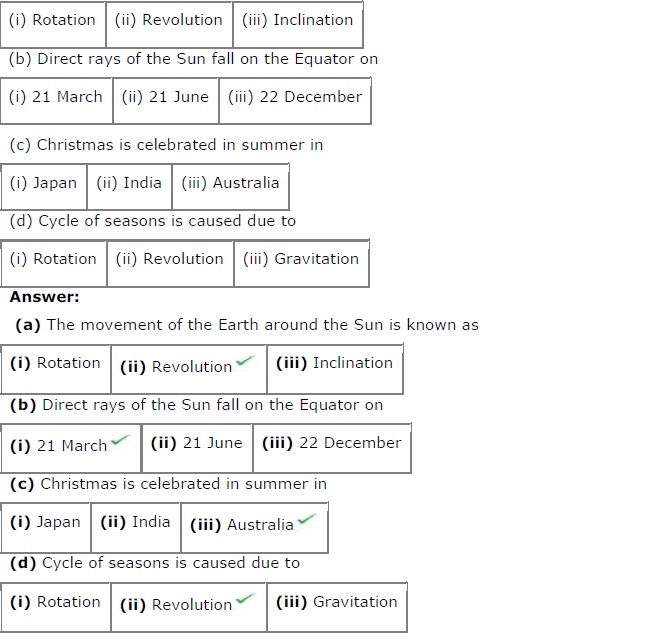Class 6 Social Science – Geography NCERT Text book Answers of Chapter 3. NCERT Solutions Class VI Social Science – Geography includes answers of all the questions of Motions of the Earth provided in NCERT Text Book which is prescribed for class 6 in schools.
National Council of Educational Research and Training (NCERT) Book Solutions for Class 6
Subject: Social Science – Geography
Chapter: Chapter 3 – Motions of the Earth
NCERT Solutions for Class 6th Social Science: Chapter 3 – Motions of the Earth
Class 6 Social Science (Geography) Chapter 3 Motions of the Earth NCERT Solution is given below.
Question 1:
Answer the following questions briefly.
(a) What is the angle of inclination of the Earth’s axis with its orbital plane?
(b) Define rotation and revolution.
(c) What is a leap year?
(d) Differentiate between the Summer and Winter Solstice.
(e) What is an equinox?
(f) Why does the Southern Hemisphere experience Winter and Summer Solstice in different times than that of the Northern Hemisphere?
(g) Why do the Poles experience about six months day and six months night?
Answer:
(a) The angle of inclination of the Earth’s axis with its orbital plane is 66½°.
(b) Rotation is the movement of the Earth on its axis. Revolution is the movement of the Earth around the Sun in a fixed path or orbit.
(c) Earth takes 365¼ days to revolve around the Sun. However, for the sake of convenience, we consider a year as consisting of 365 days. The six hours (1/4th of 24 hours) that are ignored make one day (24 hours) over a span of four years. This surplus day is added to the month of February. Thus, every fourth year, February has 29 days, and such a year (with 366 days) is known as a leap year.
(d)
| Summer Solstice | Winter Solstice |
| It is the position of the Earth when the rays of the Sun fall directly on the Tropic of Cancer. | It is the position of the Earth when the rays of the Sun fall directly on the Tropic of Capricorn |
| In this position, the North Pole is tilted towards the Sun. | In this position, the North Pole is tilted away from the Sun. |
| A larger portion of the Northern Hemisphere gets light from the Sun; hence, it is summer in the Northern Hemisphere. | A larger portion of the Southern Hemisphere gets light from the Sun; hence, it is winter in the Northern Hemisphere. |
| During this period in the Northern Hemisphere, days are longer than nights. | During this period in the Northern Hemisphere, nights are longer than days. |
(e) Equinox is the position of the Earth when the rays of the Sun fall directly on the Equator. At this position, neither of the Poles is tilted towards the Sun. As a result, the entire Earth has equal days and equal nights.
(f) When the North Pole is tilted towards the Sun, the Northern Hemisphere experiences Summer Solstice. At this time, since the South Pole is tilted away from the Sun, the Southern Hemisphere experiences Winter Solstice. When the North Pole is tilted away from the Sun, the Northern Hemisphere experiences Winter Solstice. At this time, since the South Pole is tilted towards the Sun, the Southern Hemisphere experiences Summer Solstice.
(g) The Poles experience about six months of day and six months of night because of the tilt of the Earth on its axis. Because of this tilt, each Pole is tilted towards and away from the Sun for about six months each.
When the North Pole is tilted towards the Sun, it experiences continuous daylight for six months. It is night for the same time period at the South Pole. These conditions are reversed when the South Pole is tilted towards the Sun.
Question 2:
Tick the correct answers
(a) The movement of the Earth around the Sun is known as

Question 3:
Fill in the blanks.
(a) A leap year has ________ number of days.
(b) The daily motion of the Earth is _________.
(c) The Earth travels around the Sun in _________ orbit.
(d) The Sun’s rays fall vertically on the Tropic of _________ on 21st June.
(e) Days are shorter during _________ season
Answer:
(a) A leap year has 366 number of days.
(b) The daily motion of the Earth is rotational.
(c) The Earth travels around the Sun in a fixed elliptical orbit.
(d) The Sun’s rays fall vertically on the Tropic of Cancer on 21st June.
(e) Days are shorter during winter season.